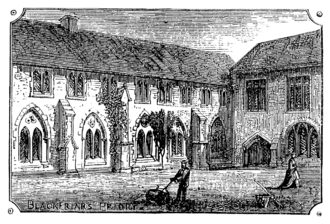Blackfriars, Bristol facts for kids
Quick facts for kids Blackfriars, Bristol |
|
|---|---|

1873 engraving of surviving buildings
|
|
| General information | |
| Architectural style | monastic |
| Town or city | Bristol |
| Country | England |
| Coordinates | 51°27′26″N 2°35′16″W / 51.457296°N 2.58772°W |
| Construction started | 13th century |
| Demolished | part demolished in 16th century |
Blackfriars, Bristol was once a Dominican priory (a type of religious house) in Broadmead, Bristol, England. It was started by a man named Maurice de Gaunt around 1227 or 1228. A famous person, Llywelyn ap Dafydd, who was the son of the last native Prince of Wales, was buried in its graveyard.
After the Dissolution of the Monasteries in the 1500s, when many religious buildings were closed, parts of Blackfriars were used for different things. It became a meeting place for groups like the Smiths and Cutlers Company, and later a place for poor people to work. Eventually, it became a Quaker meeting house, which is a place of worship for the Religious Society of Friends (Quakers). In more recent times, it has been a local register office, a theatre, and even a restaurant.
Contents
The Story of Blackfriars, Bristol
How Blackfriars Began
Blackfriars started as a Dominican priory around 1227. Dominican friars were a group of religious men who wore black hooded cloaks over their white clothes. This is why they were called "Blackfriars." The priory was built in an area of Bristol called Broadmead, just north of the old town walls.
King Henry III helped a lot with building the church and priory. It took over 40 years to finish! The king provided oak wood from the Forest of Dean. He also gave the friars gifts and a share of the fish caught in the port.
In 1232, the friars received a special permission from the king. This allowed them to build a pipe system to bring fresh water from a place called Peniwell (now Pennywell). Later, this water system was given to the Mayor and town council. In return, the town gave the friars another pipe that supplied water from Baptist Mills.
Changes Over the Years
In 1287, Llywelyn ap Dafydd, who was a prince from Wales, died while he was held captive in Bristol Castle. He was buried in the Blackfriars graveyard.
A man named John Hilsey was the leader of the Blackfriars priory. In 1534, he became the head of the Dominican order in England. Later, Thomas Cromwell asked him to help Henry VIII inspect and close down religious houses across England. This was part of a big event called the Dissolution of the Monasteries.
In 1538, the four remaining friars at Blackfriars gave up their buildings and everything inside. In 1540, William Chester, who had just been the Mayor of Bristol, bought the land from the king. The area was quite large, about 6.75 acres (2.73 hectares).
Life After the Monks
During the time of Elizabeth I, parts of Blackfriars were bought by the Smiths and Cutlers Company. This was a group for people who made tools and knives. They then rented out parts of the building to the city council in 1654. These parts were used as a workhouse, a place where poor girls could live and work.
Eventually, the Smith's Hall and the nearby Baker's Hall were bought by the Religious Society of Friends, also known as Quakers. Because of this, the buildings became known as Quakers Friars. In 1681, a group of people led by John Hellier attacked the Quakers' meeting hall. This happened during a time when Quakers faced difficulties because of laws like the Conventicles Act 1670.
Blackfriars Today
Some of the original parts of Blackfriars still stand today, though they have been changed a lot over time. These old structures have been studied by English Heritage, a group that looks after historic places. In the late 1900s, the buildings were home to the Bristol Register Office, where births, deaths, and marriages are recorded. For a short time, it also housed the Show of Strength Theatre Company. Since 2008, after the Broadmead area was redeveloped, a restaurant has been located there.

